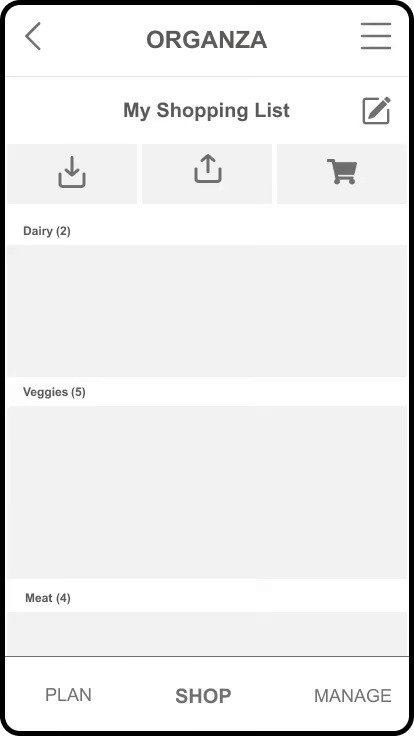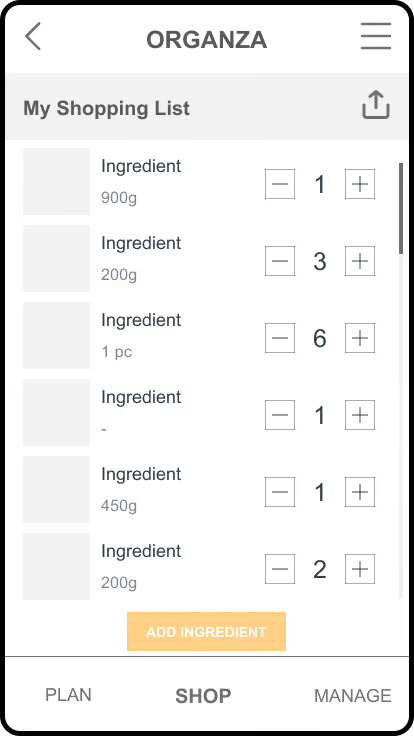Organza
Overview
Organza is the conceptual design presented for an app to reduce food waste. This conceptual design and report was created for a group project at DePaul University. The following project details were produced by myself and three others.
Contributions
Role: One of four UX Designers in a shared project
Responsibilities: Collaborate on Figma prototypes, create personas and user flow, moderate usability test, and suggest design recommendations
Duration:March 2021 - May 2021
Tools: Figma, Adobe XD
Background
The goal of our research project is to investigate how people deal with expired food. The contents of this report are based upon remote, one-on-one interviews examining how individuals prioritize consuming perishables before they expire and how often the average person throws away expired food. An informed consent procedure preceded each interview, and only the responses and general demographics of the participants were documented.
We interviewed a diverse group of people from different age groups and different lifestyles. We discovered several generalizable findings from our interviews – everyone was frustrated about food waste. The responses from these interviews were then analyzed to create three unique personas to use as reference for future design ideas aimed at helping individuals consume food before it expires. The major findings we found indicated that most people feel awful and disappointed from throwing away food which eventually results in wasted money and resources. Our focus is to help people organize and manage food supply and avoid food waste. Thus, this report contains details and analysis of our research process and resulting user personas and activity concepts.
Research
Interviews
Due to the COVID-19 pandemic, most interviews were conducted via Zoom or telephone. In total, 11 participants were interviewed. Each interviewee was asked questions related to their food consumption, prevention of food waste, and attitudes around waste.
Script
Informed Consent:
- Can I ask you some questions about how you keep track of and manage perishable foods? It should take about 10 minutes.
- You do not have to answer a question if you feel uncomfortable with it. Also, I will not record your identity with any answers you provide.
- Are you ok continuing?
Questions:
- How often do you shop for groceries?
- How often do you cook?
- How do you choose what meal to cook?
- How do you check the quality of food you choose at the store/market?
- Can you provide specific examples of perishables that you purchase?
- How do you keep track of food/edibles (expiring?) in your household and prevent yourself from purchasing too much of the same item?
- How often do your items go past their expiration date or go bad?
- How much money do you estimate is wasted on expired food each month?
- How would you know if your food is still safe to eat?
- What food do you know is currently going bad, or about to expire in your cabinets or in your fridge?
- Can you describe a situation when you find spoiled/expired food in your fridge? and what did you do with it? How do you feel about it?
- Under what conditions would you eat expired food? Or not?
- What are some methods or strategies you use to use up your food before it expires?
- How do you prevent your food from going bad too soon?
- Do you have any other thoughts or comments?
Results
Our interviewees responses revealed that people do not waste as much food as we (and they) expected. The dollar estimation of food waste is about $20-30 per person a month, but still, food waste remains a priority concern for most people. Lifestyle and how often an individual cooks seemed linked to food waste.
Some common findings:
People usually check the fridge so that they know what items they already have before they go grocery shopping. Lists are helpful tools to keep track of items that are needed when grocery shopping.
Patterns of food waste and food usage:
- 64% of participants cook meals based on the supply they have in their fridge.
- 18% use meal planning services, when they select meals or specific ingredients ahead of time.
- 64% of people will eat food past the expiration date if it looks, smells and taste fine.
Attitudes about food waste:
Only one out of the eleven participants was fine throwing food away because she does not do it very often and “it happens”. Everyone else reported feeling awful, annoyed, or disappointed about wasting food.
Some participants reported planning out their meals weekly to reduce overall waste.
Analysis
Personas
Based on our interviews, we settled on developed three different user personas that best represented the findings from our research.
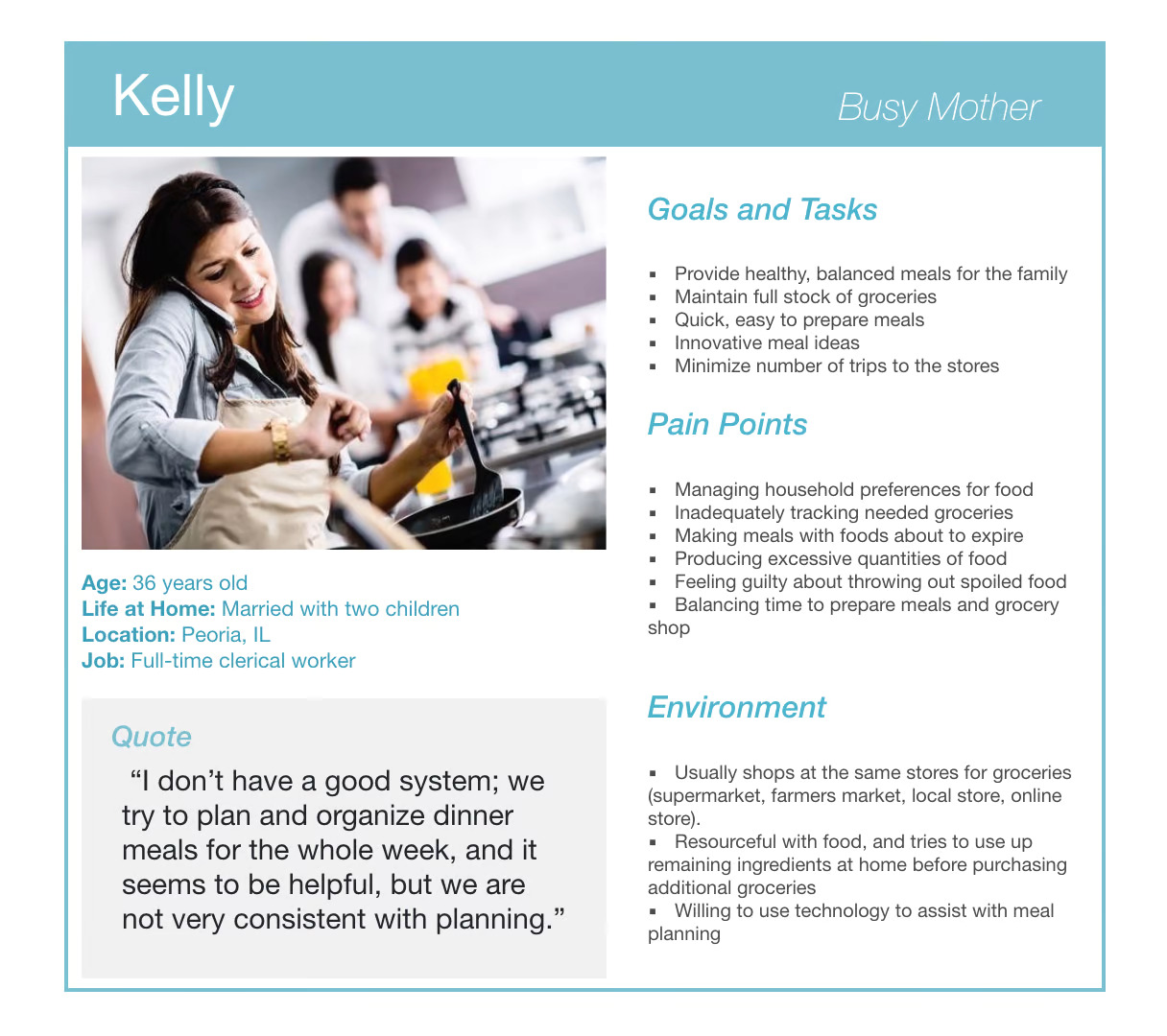

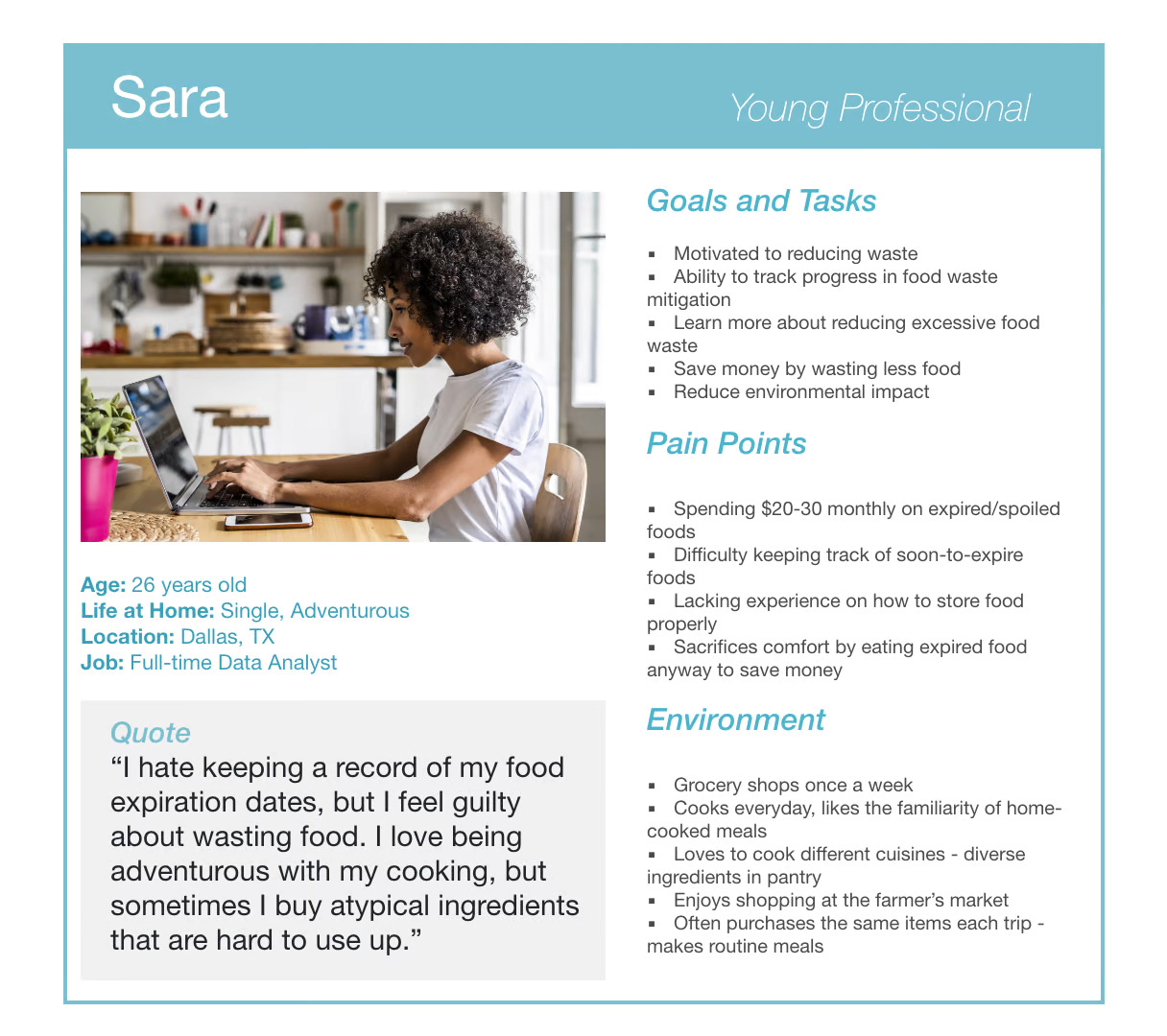
Conceptualization
User Flow
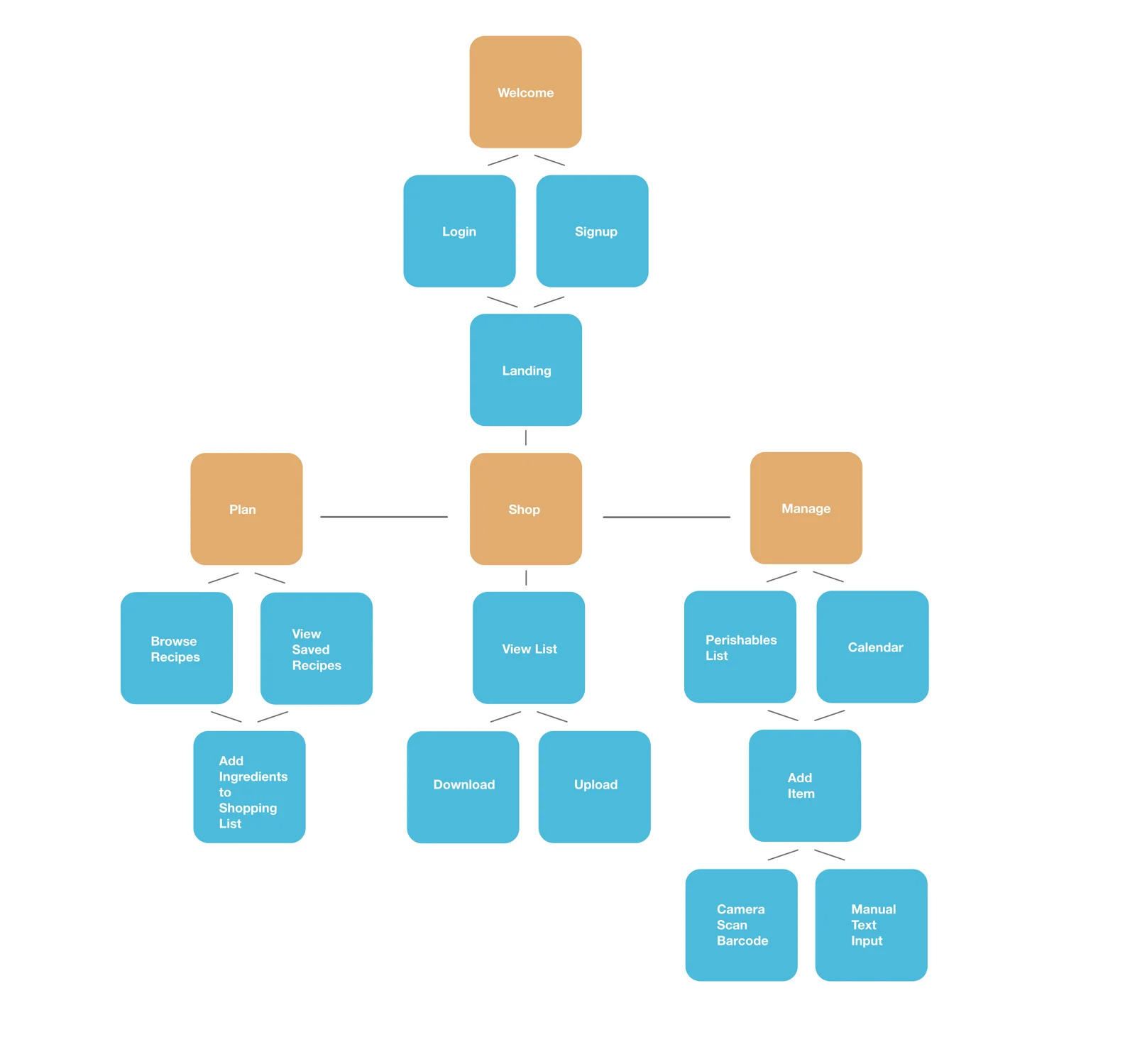
Development
Wireframes & Scenarios
Logging in and setting up a profile
Michelle can download the application and enter personal information to set-up her account. After logging in, she can add other household members who can participate in food planning, cooking, and shopping. Additionally, in the profile she can establish personal preferences for diet, cuisine type, number of people in household, and local grocery stores they can order food delivery from, as well as add payment methods.
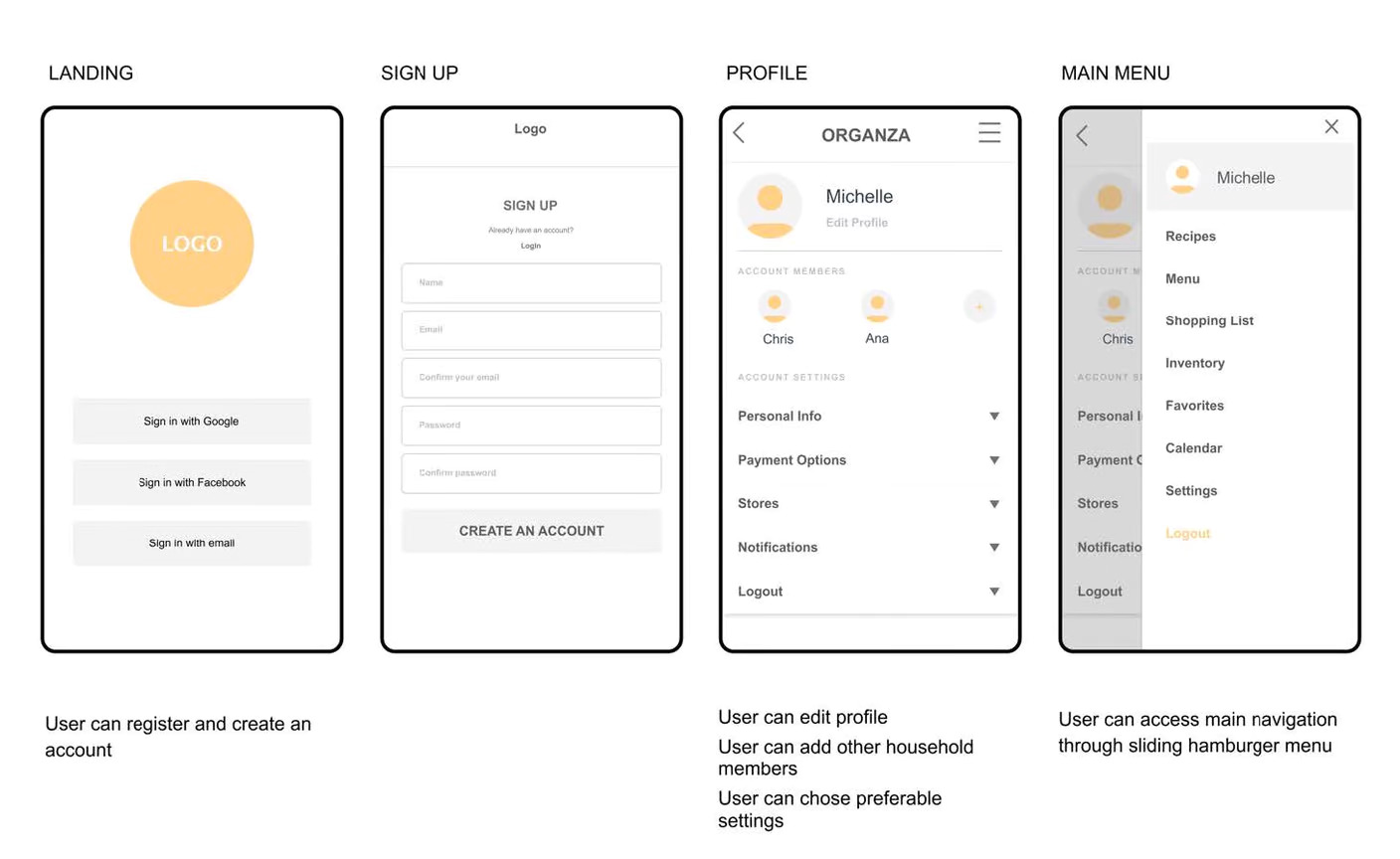
Tracking, scanning and adding ingredients at the grocery store
Michelle wants to buy food she will use and use the ingredients she already has. Purchasing from a list of ingredients provided by the recipe planner will allow Michelle to use food before it expires. Michelle needs to have a list of items that are going to expire, so she remembers to use them. The calendar will help Michelle visualize how soon foods will expire, so she can plan recipes in advance that will use these ingredients.
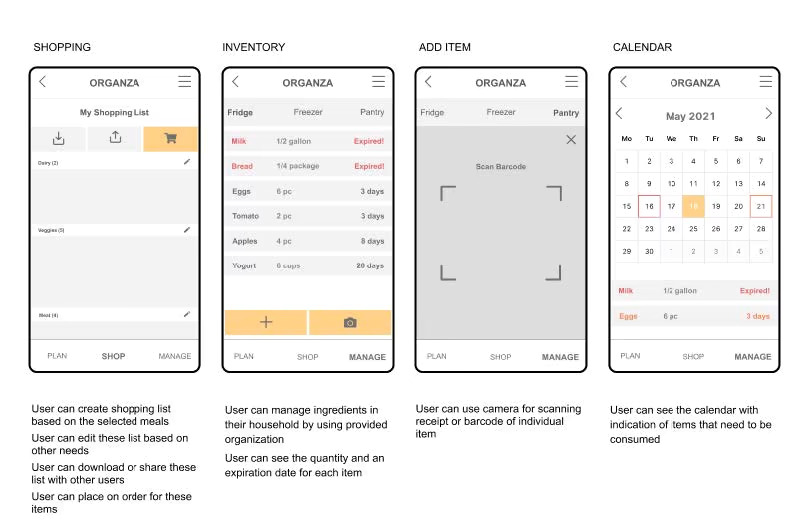
Choosing recipes to use ingredients before they expire
Users like Michelle, Kelly, and Sara can browse based on recipe or cuisine. Recipe pages include lists of ingredients, so users can select recipes that use up ingredients before they expire. Users may plan recipes by adding them to the menu for each calendar day.
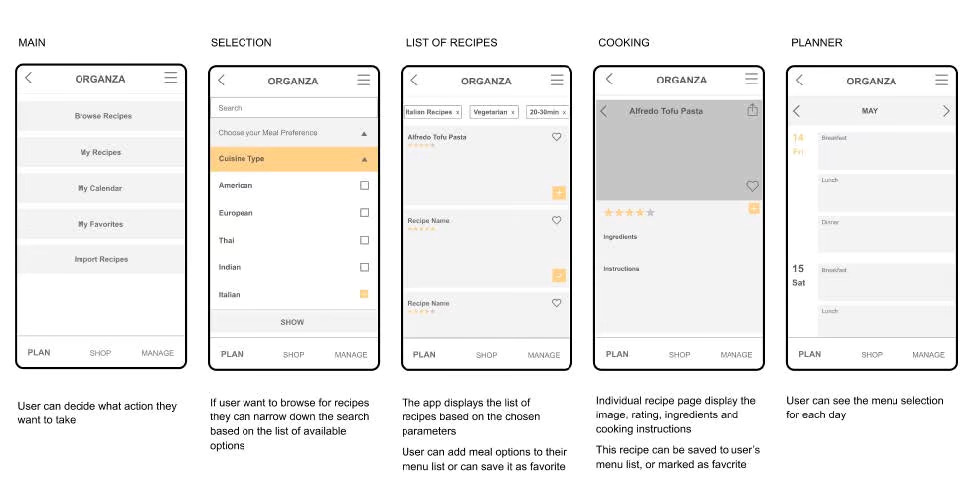
Evaluation
Usability Testing
Procedure
Using a Figma prototype created from our wireframes, we developed a means for testing the functionality of our app, Organza. Each group member conducted a usability test and evaluated how their subjects completed the following tasks:
- Can the user search and find recipes they would like to cook using the filters and recipe finder?
- Can the user create a shopping list and add items to it?
- Can the user view already purchased items and determine expiration dates?
Results
Overall, we received positive feedback on the app, and it's ability to potentially reduce food waste. Individuals were able to complete tasks 1 and 3 in about 15-30 seconds. Task 2 took the longest, and many users struggled with the navigation and understanding the purpose of the shopping list. For some users, adding items proved confusing.
Users also expressed confusion with having the profile screen as the landing page. Some users suggested having a more engaging home page that could show feature recipes, rather than the login/profile page.
Iterations
Prototype Redesign
After evaluating the user-feedback, we changed two screens to improve the usability of our application.
Navigation
We noticed that in general, our users experienced navigation difficulties when tasked with using our application. To solve this, we simplified the navigation menu so that it was limited to three main categories: plan, shop and manage. We re-distributed the remaining menu categories into subcategories. The user can select from the three main categories to see additional components within these general tasks.
Old
Revised


Shopping List
In our usability test, the lack of structure in the shopping list proved confusing. In a remedial design, we added additional structural elements, such as an explicitly labeled button for adding ingredients, add (+) and subtract (-) buttons for changing quantities, and eliminating some of the header icons.
Old
Revised
